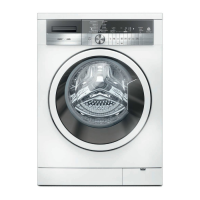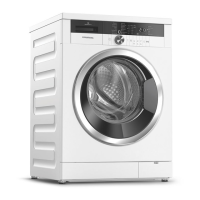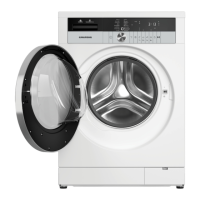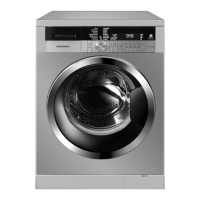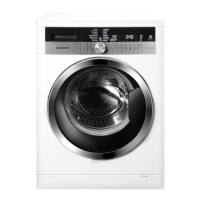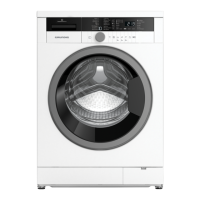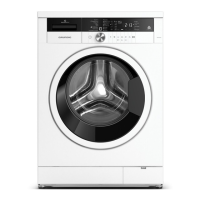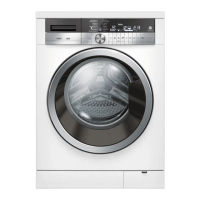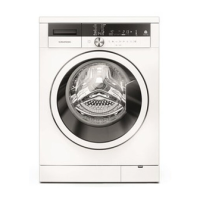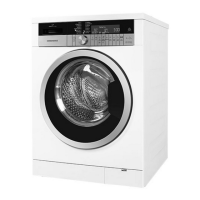Do you have a question about the Grundig GWN 47430 CB and is the answer not in the manual?
Safety guidelines for product usage by children and adults, including supervision requirements.
Precautions regarding electrical connections, potential hazards, and proper grounding of the appliance.
Defines the product's purpose for domestic use only and restrictions on other applications.
Measures to protect children from hazards associated with the appliance and its packaging materials.
Information on the product's compliance with waste electrical and electronic equipment regulations.
Details on the recyclable nature of packaging materials and proper disposal instructions.
Visual identification of the washing machine's main components and parts with numerical labels.
A list of all items included in the product packaging, with numerical and alphabetical references.
Detailed technical data including energy efficiency, consumption, dimensions, and performance metrics.
Guidance on selecting a suitable, stable, and safe place for the washing machine's installation.
Step-by-step instructions for safely removing protective packaging elements before installation.
Procedures for detaching transport safety bolts to allow the machine to operate correctly.
Instructions for connecting the water inlet hoses, including pressure requirements and tap connections.
Guidelines for properly connecting the drain hose to ensure efficient water discharge.
Steps for leveling the appliance using adjustable feet to ensure stable operation.
Requirements for connecting the washing machine to the electrical supply and safety precautions.
Instructions for safely preparing the machine for transport, including draining and securing it.
Advice on separating laundry items based on fabric type, color, and soiling for optimal washing.
Pre-wash preparations for laundry items, including removing accessories and treating stains.
Tips for using the washing machine efficiently to conserve energy and water resources.
Procedures to follow before the first wash cycle, including safety and installation checks.
Guidance on determining the appropriate amount of laundry for different wash programs to ensure performance.
Instructions on how to correctly place laundry items into the drum for safe and effective washing.
Best practices for adding detergents and softeners, including dosage and compartment usage.
Recommendations on selecting appropriate detergents based on fabric type, color, and wash requirements.
Guidelines for adding and using detergents, softeners, and other cleaning agents in the correct compartments.
Factors influencing detergent quantity, including laundry weight, soiling, and water hardness.
Instructions for correctly filling and using the softener compartment for optimal fabric care.
Specific instructions for using liquid detergents, including the use of a dosing cup and avoiding stains.
Guidance on placing gel and tablet detergents into the correct compartments or directly into the drum.
Procedures for adding starch to the washing cycle and post-use cleaning recommendations.
Instructions for safe and effective use of bleaching agents, including dosage and compatibility.
Recommendations for using limescale removers specifically designed for washing machines.
Identification and function of buttons, displays, and indicators on the washing machine's control panel.
Explanation of various symbols displayed on the control panel, indicating machine status and functions.
Pre-wash checks and actions, including hose connections, power, tap, and detergent addition.
Guidance on choosing the appropriate wash programme based on laundry type, quantity, and soiling level.
Description of primary wash programmes like Cotton, Synthetics, and WoolProtect for different fabric types.
Details on special wash programs such as GentleCare, Cotton Eco, and Anti-Allergy for specific needs.
Information on programs like Rinsing and Spin+Pump for specific washing tasks.
How to adjust and set the washing temperature for selected programs, including available ranges.
Explanation of the Prewash function and its benefits for heavily soiled laundry.
Details on the Express function for reducing wash times and rinses for lightly soiled items.
Information on the Extra Rinse function to remove detergent residue, beneficial for sensitive skin.
Guidance on using Silent Mode for energy-efficient and quiet washing, including spin cycle adjustments.
Functionality for delaying the start of a wash program up to 24 hours for user convenience.
How to initiate a wash cycle using the Start/Pause button after setting the program.
Explanation of the door locking mechanism and the 'Door Locked' symbol indication.
Instructions on how to add laundry or change settings during an active wash cycle.
How to activate and deactivate the Child Lock feature to prevent accidental changes to the program.
Steps to abort a running wash program and turn off the machine by holding the On/Off button.
Indicates when a wash cycle is complete and the machine's behavior after completion.
Instructions for adjusting the audible volume level of the machine's signals and alerts.
Information on the automatic energy-saving Standby Mode and its indicators.
Essential steps to prepare the washing machine before starting a wash cycle.
Guidance on choosing the most suitable wash program for different types of laundry.
How to select and apply additional functions to customize wash cycles.
The process of initiating a wash cycle after selecting the program and settings.
Instructions for regularly cleaning the detergent dispenser to prevent blockages and residue buildup.
Procedures for cleaning the washing machine's drum and door seal to maintain hygiene and performance.
Methods for cleaning the exterior surfaces and the control panel of the washing machine.
Steps to access and clean filters in the water inlet hoses to prevent debris entry.
How to drain residual water and clean the pump filter to ensure proper drainage and pump function.
Solutions for issues where the wash program fails to initiate after the door is closed.
Steps to take if the washing machine fails to draw water for a cycle.
Solutions for problems where the machine is unable to discharge wash water.
Causes and remedies for excessive vibration or noise during operation.
Reasons why the loading door remains locked and how to resolve it.
Factors that can cause wash cycle times to exceed the stated duration.
Troubleshooting for countdown timers not progressing as expected on models with displays.
Diagnosing why the machine fails to proceed to the spin cycle.
Addressing issues causing laundry to appear grey after washing due to detergent or temperature.
Solutions for common washing issues like persistent stains or lack of whitening.
How to prevent unpleasant odors in laundry and the machine by ensuring proper hygiene.
Causes for color fading in laundry and how to prevent it through correct washing practices.
Reasons why laundry might become stiff and how to achieve softer results.
Identifying causes of detergent buildup in the dispenser and cleaning methods.
How to manage excessive foam generation caused by detergent usage.
Causes for laundry being excessively wet post-cycle and solutions involving spin or drum cleaning.
Outlines the scope of coverage for product repairs under the manufacturer's warranty.
Lists exclusions from the warranty, including transit damage, consumables, and misuse.
Key considerations and conditions related to the product's warranty and proper usage.
Information on the manufacturer's policy regarding product replacements versus repairs.
Details regarding the scheduling and availability of service engineer appointments.
Conditions under which service calls may incur charges, such as lack of proof of purchase or no fault found.
Instructions on how to request service and the necessary information required for warranty claims.
| Appliance placement | Freestanding |
|---|---|
| Loading type | Front-load |
| Product colour | White |
| Built-in display | Yes |
| Door colour | Black |
| Drum material | Stainless steel |
| Rated capacity | 7 kg |
| Maximum spin speed | 1400 RPM |
| Spin-drying class | B |
| Washing class | A |
| Number of washing programs | 15 |
| Noise level (spin) | 74 dB |
| Noise level (wash) | 55 dB |
| Delayed start timer | Yes |
| Delay start (max) | 24 h |
| Child lock | Yes |
| Energy efficiency class | A+++ |
| Water consumption per cycle | 45 L |
| Width | 600 mm |
| Height | 840 mm |
| Capacity | 7 kg |
| Spin Speed | 1400 RPM |
| Noise Level (Washing) | 55 dB |
| Color | White |
| Control type | Rotary |
